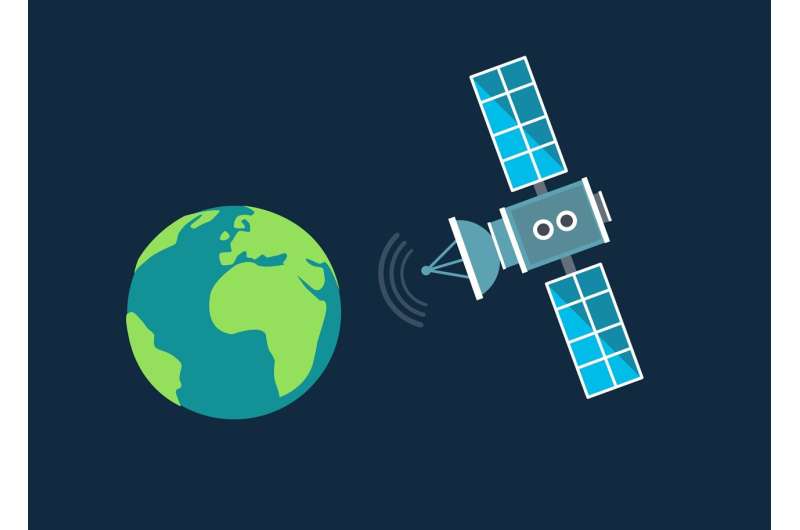This article has been reviewed according to Science X's editorial process and policies. Editors have highlighted the following attributes while ensuring the content's credibility:
fact-checked
peer-reviewed publication
trusted source
proofread
How to create an efficient network between the Internet of Things and satellite constellations

A total of 4.6 billion people are connected to the internet through their mobile phones. For each of these people, there are more than three devices communicating with the internet. The Internet of Things (IoT) is composed of all connected objects, which are growing in number: today's 15 billion are expected to have risen to 30 billion by the end of the decade.
The IoT, which includes objects ranging from cars to irrigation sensors, weather stations in remote places and autonomous drones, is opening up countless new opportunities for communications and data. However, it also faces significant hurdles.
One of the main barriers involves how to connect objects to the internet in places where there is no mobile network infrastructure. The answer seems to lie with low Earth orbit (LEO) satellites, although the solution presents its own challenges.
A new study led by Guillem Boquet and Borja Martínez, two researchers from the Universitat Oberta de Catalunya (UOC) working in the Wireless Networks (WINE) group of the university's Internet Interdisciplinary Institute (IN3), has examined possible ways to improve the coordination between the billions of connected objects on the surface of the Earth and the satellites in its atmosphere.
The paper is published in the IEEE Internet of Things Journal.
The importance of satellites for the IoT
The Internet of Things' exponential growth during the last decade has boosted innovation in very diverse fields ranging from logistics to smart cities, agriculture and shipping, among others. To a great extent, the IoT revolution has been made possible by the effectiveness of what is known as low-power, wide-area networks (LPWANs) and the terrestrial infrastructure built for mobile telecommunications.
However, in spite of its great effectiveness, this solution suffers from an unresolved issue: how to connect IoT devices in remote locations and rural areas where this infrastructure is not available.
LEO satellite constellations have emerged in recent years as an alternative solution capable of overcoming the limitations of terrestrial networks. "LEO satellites are particularly relevant when it comes to the IoT because, being closer to the Earth, they need less transmit power to achieve reliable communication. This means that devices can save energy, extending battery life and saving on maintenance costs," said Boquet.
"Among other advantages, deploying a low Earth orbit satellite is considerably cheaper, which means that connectivity services can be provided at prices that are more reasonable for the IoT."
Furthermore, LEO satellites—such as the Spacex Starlink and Eutelsat OneWeb satellites and Amazon's Kuiper project—allow much lower latency (delay between communications) than geostationary satellites, have many more satellites in operation and greater coverage, can be deployed much more quickly and are suitable for use in communications in many sectors. However, using this option for the IoT brings its own challenges.
Challenges of using satellite constellations for the IoT
Using satellites as part of the IoT network presents problems of its own. Some of these relate to the development of the industry (we are unlikely to be able to deploy mega satellite constellations to ensure uninterrupted coverage in the short term due to their low cost effectiveness when used for the IoT), and others relate to limitations linked to the way the technology itself has been designed, such as the increased likelihood of interference between communications, limitations regarding IoT devices' use of power, and the difficulties involved in synchronizing these devices' duty cycles with satellite communication availability intervals.
"IoT devices tend to be battery-powered and have regular sleep and wake-up duty-cycling intervals to save energy. These regular duty cycles are commonly used in terrestrial communications, where they are even standardized. However, as LEO constellations don't provide uninterrupted coverage, what you end up with is short, irregular communication windows," said Boquet.
"We therefore need to develop more advanced synchronization strategies to ensure reliable communication and access to the connection opportunities provided by the satellite network."
How to improve synchronization between satellites and IoT devices
The power-saving modes in IoT devices, based on the energy conservation times during which they can extend their battery life by going into sleep mode, rely on regular periods. But this is not how satellite constellations work. To synchronize the needs of connected objects with LEO satellite access times, you must be able to predict where each satellite is going to be and when the communication window will open.
"Our proposed solution is to synchronize the IoT application's transmission needs and the network's communication needs on the one hand with the satellite's availability times on the other. This synchronization is based on the ability to predict these times by using a model of the satellite's orbital path, starting from a known initial point," said Boquet.
"However, making predictions has a cost in terms of energy, as it requires regular calculation operations to be made and the predictive model to be updated when it deviates from the actual situation."
The solution developed by the researchers at the UOC was tested in a real communication situation with the Enxaneta nanosatellite, the first satellite deployed by the Government of Catalonia under its NewSpace project. The results were promising: the satellite access ratio improved by up to 99%, ensuring long-term access to the network while minimizing the device's energy consumption.
"The next steps are to complete the cost-benefit analysis of implementing the solution, taking into account various applications, service networks, types of satellite constellation, IoT devices and communication technologies; and then to propose and put in place energy-saving modes that automatically adapt to communication needs and the changing conditions of non-terrestrial networks," said the researcher.
More information: Guillem Boquet et al, Low-Power Satellite Access Time Estimation for Internet of Things Services Over Nonterrestrial Networks, IEEE Internet of Things Journal (2023). DOI: 10.1109/JIOT.2023.3298017



















